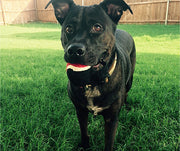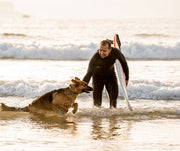How To Keep Your Pet Safe This Summer

Summertime Pet Safety
Summertime means sun, beach, and lots of play outdoors with your dog or cat. Summer can be a great time to bond with your pet. But higher temperatures also mean higher risks for our pets – more injuries, more ear and skin infections, and even the possibility of heat stroke.
It is important to Keeping Your Pet Safe in the summer. Learn how to know how to prevent your pet from the most common summer health risks, stay calm about your pet’s health, and not follow any myths about pet protection during the hot summer months. the most common summer risks for your pet are:
• Overheating
• Sunburn
• Dehydration
• Stroke
Pets do not sweat in the same way humans do and can easily become overheated. To avoid these problems and enjoy the summer season with your pet, here are some helpful tips to keep in mind.
Plenty of water and shade
Dehydration in dogs and cats is a real possibility during the summer. Dogs get much thirstier than people do when they get hot. Signs of dehydration include excessive drooling and dry gums. Make sure your pet always has access to fresh, clean water inside the house, and bring a water bottle for your pet when going outside, just like you would do for yourself. You might also switch to wet dog food during the hotter months to increase fluid intake.
Keep your pet in the shade as often as possible. While dogs and cats like to sunbathe, direct sunlight can overheat them (especially dogs) and lead to heat stroke.
Know the signs of overheating
You may wonder how hot is too hot for cats. Or how hot is too hot to walk dogs? What temperature can a cat tolerate? A dog’s normal temperature is between 100° and 103°F, while a normal temperature in cats ranges from 100.4º to 102.5ºF. Anything higher than that means pets are in danger. Dogs and cats don’t sweat as humans do. They pant and drink water bringing down their body temperature. keeping your pet safe this summer means watching for these possible symptoms of overheating:
• Heavy panting
• Dry or bright red gums
• Thick drool
• Vomiting
• Diarrhea
• Wobbly legs.
Never leave your pet in the car
Most pets love riding in cars. But they are not going to enjoy being stuck in it somewhere in the parking lot when it heats up to over 100 degrees. You may think leaving your pet in a car for a few minutes is no big deal. However, it can take less than 10 minutes to develop heat stroke in dogs and cats inside a hot vehicle. Make sure if you have to go out of the car, always leave the dog in the car with AC running, but it would be best not to do it at all, if possible.
Apply sunscreen
Pets get sunburns too, especially those with short or light hair coats. And just like with people, it hurts and can even lead to skin cancer. If you are planning to spend a day out in the sun with your furry companion, apply sunscreens every 3-4 hours to the least hair-covered spots: bellies, ears, and nose. Use only sunscreens made specifically for pets. Pets tend to lick it and sunscreen made for humans can include components that are toxic for animals and this can cause an emergency situation. Ask your vet if unsure of a product suitable for your pet.
Don’t shave your pet
Shaving your dog, or a cat for the summer is not a solution to overheating. A pet’s coat is naturally designed to keep it cool in the summer and warm in the winter. Feel free to trim the fur on your pup in the summer, but never shave. Be sure to leave at least a full inch of hair to protect your pet’s skin from sunburns. And don’t forget about your pet’s regular grooming schedule, no matter what season it is.
Take note of your walking hours
If you have a dog, walk, and exercise your pup only in the early morning and late evening. When is it too hot to walk a pup? Never do it in the middle of the day. When outside, take breaks in the shade and have water available.
Keep your dog’s paws cool
Pets heat and cool from the bottom up. If you’re out in the sun together, try to keep your pet off hot surfaces like cement and asphalt. Not only can it burn paws, but it can also increase body temperature and lead to overheating. It’s also not a good idea to drive around with your dog in the back of a truck as the hot metal can burn paws quickly.
Keep parasites off
In summer, fleas, ticks, mosquitoes, and other parasites are practically everywhere. They carry tapeworms, heartworms, and diseases such as Lyme or Bartonella that can put your pet at risk. Ask your vet for the appropriate medical prescriptions to keep your dog or cat pest-free.
Consider a life vest
Just like people, our dogs enjoy cooling off in water, pool, lake, or ocean. But be very careful where you choose to let them. Not all pets can swim or swim well. And even those that do, might not know how to get out of the pool. Also, strong currents and riptides can sweep a dog out to sea. If you decide to take your dog sailing or boating, be sure it wears a life vest in a bright color to stay visible and afloat in case of an accident. Always keep an eye on your pet when near water.
Follow the above tips keeping your pet safe this summer.
Previous article

Next article

Related posts
View all-

What Can You Use Instead of Cat Litter?
Traditional cat litter is convenient, but it’s not the only option. Many cat owners look for alternatives to reduce waste, save money, or avoid chemicals found in clay-based kitty litter. Some options offer better odor control, while others are more eco-friendly or gentler on a cat’s paws.
Read Article -

How to Keep My Backyard Smelling Fresh
A clean backyard should smell fresh, unlike pet waste, smoke, or mold. Bad smells can linger, especially when dog poop, urine, or food scraps attract flies and bacteria. If your yard has a foul odor, it's time to take action. The first step is cleaning up pet feces, trash, or rotting food. A garden hose can wash away dirt and urine from artificial turf, patios, and decks. To neutralize odor, Use baking soda, white vinegar, and essential oils.
Read Article -

What Supplies Do First-Time Cat Owners Need?
Bringing home a new cat is exciting, but making them feel safe and comfortable takes more than love. First-time cat owners must prepare with the right supplies to ensure a smooth transition. From a litter box to cat food and a warm bed, having the basics ready can help your new kitty settle in faster. This guide covers everything a new cat owner needs to make their new pet feel at home.
Read Article



